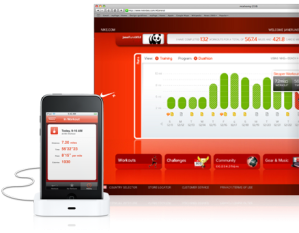By Jeff Zimmerman
Anyone who’s been in a room with me longer than 5 minutes knows that I am unabashedly and incurably obsessed with my iPhone. It almost instantly became inextricably integrated into my life. The new anytime/anywhere Internet quickly turned me into a junkie, and I didn’t understand the severity of my addiction until I found myself fighting off the shakes and nausea from connectivity withdrawal during a cross-country flight.
Naturally, when Apple previewed iPhone software 3.0 a couple of weeks ago, I was there, feverishly refreshing live feeds on the gadget blogs. Most of the improvements were evolutionary, which doesn’t bother me. I don’t need to be wowed every year. The additions in iPhone 3.0 are mostly obvious but welcome nonetheless. I was, however, intrigued by the possibilities opened up by one particular feature.
iPhone software 3.0 will allow third party devices to interact with an iPhone or iPod touch via Bluetooth, Wi-Fi, or Apple’s 30-pin connector. At first, I thought “big deal, move along”, but then LifeScan demoed a glucose monitoring app for diabetics (about 43:30 into the presentation). The app collects blood glucose readings from enabled meters and plots them over time. It can also contact someone (a parent, spouse, doctor, etc.) if a reading is outside the safe zone and suggest insulin doses based on what someone is planning to eat.
I thought MY life depended on my iPhone. Integration with medical devices has the potential to improve people’s health and quality of life quite substantially. While considering possibilities, my mind went to my mother and my aunt who both suffer from heart problems.
My mother suffered a heart attack last June. Afterward, she had to monitor her exercise routine and heart rate, ensuring that it stays in the right range for the right amount of time. Initially, she was worried and frustrated because it was difficult for her to know if she was hitting and maintaining the right heart rate. To help her manage this (and give her something to listen to at the gym), we got her an iPod touch and Nike+ receiver. The receiver attaches to her shoe and sends information about her pace and distance to the iPod. When she synchs the iPod, iTunes uploads the information to nikeplus.com. There, she can compare routines and chart her progress over time. This eased some of her concerns by enabling her to compare routines she was doing on her own to those she was doing with rehab nurses at the hospital.

Nike+ app running on an iPod touch and nikeplus.com workout information
She also wears a heart monitor while exercising but has to track her heart rate manually. The device only saves information from your last reading. An iPod touch running iPhone 3.0 could theoretically communicate with her heart monitor and track it for her. It could plot her heart rate against her pace, showing that her heart was getting stronger as she became capable of walking faster and/or longer. During a routine, it could interrupt the music to tell her that her heart rate was too high. She and her cardiologist could look at the data and tweak her routine more regularly. It would virtually eliminate guesswork, which could speed up recovery time.
My aunt has a pacemaker with a defibrillator. The intricate machine requires regular maintenance checks with the manufacturer over a land phone line. A few minutes on the phone per week to maintain a device that is saving your life is hardly something to complain about, but the process isn’t perfect. Sometimes the reading is incomplete because the phone connection was bad. She cannot do the reading if she is not near a land phone line because cell phones create too much interference. If an iPhone could communicate with the pacemaker, it could gather the data and send it to the manufacturer over the Internet or cell network, eliminating these inconveniences.
The iPhone could also alert her doctor of anything out of the ordinary occurs – like using the defibrillator – allowing the doctor to detect problems earlier and monitor them more closely. It could contact my uncle and emergency care with her location (thanks to GPS) if she collapses. It could monitor the pacemaker’s battery level, prolonging the need for surgery to replace it.
Obviously, this is just speculation based not on medical knowledge but on others’ experiences with ongoing health issues. Maybe some of what I’m thinking is already out there. I also have no idea whether or not these devices can interact with computers or other mobile devices to do anything like I’m imagining. However, I can guess that most other systems in place will not be as easy as the iPhone’s. With the new iPhone software, the medical community has the potential to use technology to improve people’s lives, and I sincerely hope they embrace this opportunity.




That’s actually a really cool thought. I hope they do embrace the tech to not only make it more stable – but to connect everything in real-time and put it into a constant track of improvement over time with the data collected previously.
That is until our iPhones give us cancer and kill us that way….